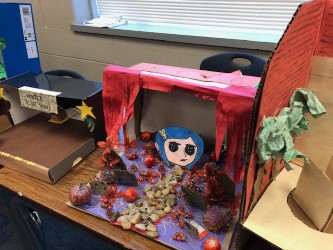Step into the Set Designer’s Role
Developed by Lauren Komorowski
Miamisburg High School
Theater
Grade Level: High School
Introduction
Professionals make things look easy! This is particularly true in sports and in the arts. It is also easy to underestimate the time and energy it takes to make a piece of art come to life. Lauren Komorowski, instructor at Miamisburg High School, had an opportunity to demonstrate the thought and energy that goes into stage design for her theater students. Traveling to New York City with the Muse Machine on their Advanced Teacher Training Seminar in 2019 provided Lauren with an appreciation of theater staging at an advanced level during the many Broadway plays that she attended there. Lauren used that experience, and her already established background in this art form, to create a lesson plan that involved her students beyond the usual “sit-and-get” kind of instruction. Her students were asked to develop a set, using accepted rules of design and to share it with the class, explaining how and why they designed it as they did. She shares that it caused her class to understand the role that set design plays as a part of the play itself. This is the kind of learning that will stay with them if they become performers, designers, or even audience members in the future!
Click here to view/download this lesson plan as a PDFInspiration
The set designs from Broadway productions of Ink and The Ferryman, viewed as part of Muse Machine’s Advanced Teacher Training Seminar in June 2019.


Overview
Summary
Students will step into the role of set designer as they create their own stages. Their stages will demonstrate an aspect of a production that will be difficult to convey on a stage. This will allow students to consider the complex job of set designer, the role of the stage as a part of the storytelling of the play and the effect a set designer’s decisions have on actors and the audience.
Standards
4CE Distinguish between the roles of actor and director and discuss how they relate to each other in a theatrical production.
5CE Recognize and identify the standards and different aspects of performance used to critique and assess theatrical works.
Objectives/Outcomes
Students will have a greater understanding of the role of set designer. Students will experience the role of designer, so they are better prepared to understand how the actions of a director affect the jobs of the others involved in a production, by creating a shoebox stage. Students will critique how a set designer sets up a stage, both from the point of view of an actor and an audience member.
Teaching Approach
Model various stage setups, discuss the issues directors may have faced and how they solved them, and student individual or collaborative work.
Assessment
Presentation of shoebox stages & self-critique
Lesson Preparation
Teacher Needs
“A Brief History of Theatre” slideshow
Various art supplies to assist student stage creation (including liquid glue, colorful paper, cardstock or cardboard, scissors)
The following videos:
Helpful Hints
Do not let students choose their scenes until after you discuss the sets you are analyzing. This allows them to brainstorm as you watch how others selected aspects from their play/musical and staged them, and then they can decide on their scene and stage elements from there.
Student Needs
Prior Knowledge
This is an introduction to staging a production. However, a general understanding of what is involved in a stage, how stages are used, and the general limitations of stages would be helpful.
Student Voice
Students can choose their scene, how they will adapt it for the stage and if/who they work with.
Vocabulary
Stage, fly space, wings, props, audience, visibility, levels
Evidence/Assessment of Outcomes
Students will present their stages to the class. Through this presentation, they will demonstrate the aspects of their stage design, an explanation of their staging choices and the overall “vision” of their staged production.
Students will also provide a written critique of their stage. They will assess the challenges this stage would provide them as an actor as well as a member of the audience.
Enduring Understandings
The students will leave this lesson with information on a career in set design and better understand what a set designer does everyday. They will gain knowledge about the challenges and benefits of this career.
Learning Plan
Prompt
Students will watch YouTube videos of two Tony-Nominated set designers discussing the thought behind and process of making their set. (Links 1 and 2 as described under Teacher Needs)
Hooks
Discussion of how sets affect our experience of a staged performance as actors and as audience members.
Essential Questions
- How does the design of a set change the way the audience perceives the important elements of a play or musical?
- How can critical thinking help solve issues that arise when staging a complex scene AND in our lives?
Resources
As described under Teacher Needs
Teacher and Student Performance Tasks
Day 1: Students will watch the YouTube interview with the set designers of The Ferryman and Ink. Teacher will identify the staging elements of these musicals and discuss the various challenges presented to the set designers, as well as the effect of these stages on the audience.
Day 2: Teacher/students will discuss the “Let it Go” scene from the movie Frozen, using appropriate stage terminology from the previous “stage elements” unit (see slides from the unit A Brief History of Theatre).
Discuss these videos in the context of the challenge of presenting this scene from Frozen (Link 3) on a stage. Students will brainstorm what the challenges of putting this scene on a stage would be, as well as a plausible solution to these issues.
Teacher will list the challenging aspects of the scene on document camera. Students will view the Broadway and Disney versions of this scene (Links 4 and 5) and evaluate how the stage director set up the stage to accommodate these issues, referencing back to the initial list of challenges and identifying how the various stage managers/set designers dealt with these difficulties. Students will break into groups and identify the scene they will be staging.
Day 3-7: Students will work individually or as a group to identify elements of the stage needed to successfully adapt their scene from the screen to the stage.
Final Review
Day 8: Students will present their scenes, focusing on the challenges they faced and how they used their set to overcome those challenges. Then, students will begin a critique of their stage, focusing on the actors and audience experience of the play because of various choices they made as a stage director.
Lesson Reflection
My students really enjoyed this project and were engaged. They have mentioned several aspects of their new learning about stage elements as we have evaluated other performances throughout the year. Often, in the past, I have found that students think every single set is perfect and have no idea how they would fix or change sets we see. After doing this lesson, they have a much richer appreciation for the work that is required to design a set.

